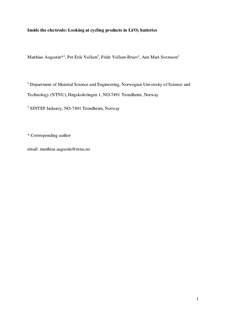| dc.contributor.author | Augustin, Matthias | |
| dc.contributor.author | Vullum, Per Erik | |
| dc.contributor.author | Vullum-Bruer, Fride | |
| dc.contributor.author | Svensson, Ann Mari | |
| dc.date.accessioned | 2020-01-24T14:54:19Z | |
| dc.date.available | 2020-01-24T14:54:19Z | |
| dc.date.created | 2019-05-01T18:57:34Z | |
| dc.date.issued | 2019 | |
| dc.identifier.citation | Journal of Power Sources. 2019, 414 130-140. | nb_NO |
| dc.identifier.issn | 0378-7753 | |
| dc.identifier.uri | http://hdl.handle.net/11250/2637896 | |
| dc.description.abstract | This work investigates the impact of electrochemical reactions and products on discharge capacity and cycling stability with electrolytes based on two common solvents – tetraethylene glycol dimethyl ether (TEGDME) and dimethyl sulfoxide (DMSO).
Although the DMSO-based electrolyte exhibits better initial electrochemical properties compared to that based on TEGDME, e.g., higher discharge capacity and potential, the use of TEGDME results in a significantly better cycling stability.
Scanning electron microscopy (SEM) and X-ray diffraction (XRD) investigations of the gas diffusion electrodes (GDE) after first discharge reveal a considerable difference in discharge product morphology. With DMSO as solvent one high-potential reduction process leads to the formation of crystalline lithium peroxide (Li2O2) particles on the cathode surface area. SEM imaging of GDE cross-sections depicts that the (non-crystalline) product film formation at lower potentials during discharge with the TEGDME-based electrolyte results in a GDE pore clogging close to the O2 inlet, so that gas transport is hindered and the discharge ends at an earlier point. The higher cycling stability with LiTFSI/TEGDME, however, is attributed to (i) the apparently complete recovery of the GDE active surface by recharge and (ii) different parasitic reactions resulting in the formation of side product particles rather than films. | nb_NO |
| dc.language.iso | eng | nb_NO |
| dc.publisher | Elsevier | nb_NO |
| dc.rights | Attribution-NonCommercial-NoDerivatives 4.0 Internasjonal | * |
| dc.rights.uri | http://creativecommons.org/licenses/by-nc-nd/4.0/deed.no | * |
| dc.subject | Lithium/oxygen batteries | nb_NO |
| dc.subject | Oxygen reduction reaction | nb_NO |
| dc.subject | Gas diffusion electrode | nb_NO |
| dc.subject | Discharge products | nb_NO |
| dc.title | Inside the electrode: Looking at cycling products in Li/O2 batteries | nb_NO |
| dc.type | Journal article | nb_NO |
| dc.type | Peer reviewed | nb_NO |
| dc.description.version | acceptedVersion | nb_NO |
| dc.rights.holder | Postprint version of article released under a CC-BY-NC-ND license | nb_NO |
| dc.source.pagenumber | 130-140 | nb_NO |
| dc.source.volume | 414 | nb_NO |
| dc.source.journal | Journal of Power Sources | nb_NO |
| dc.identifier.doi | 10.1016/j.jpowsour.2018.12.088 | |
| dc.identifier.cristin | 1694959 | |
| dc.relation.project | NORTEM: 197405 | nb_NO |
| cristin.unitcode | 7401,80,64,0 | |
| cristin.unitname | Materialer og nanoteknologi | |
| cristin.ispublished | true | |
| cristin.fulltext | postprint | |
| cristin.qualitycode | 1 | |

